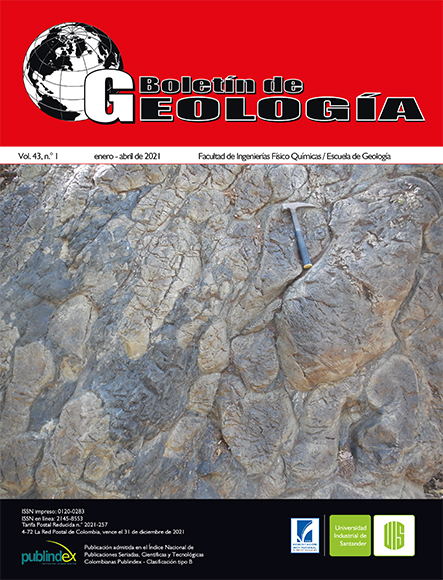Application of the wavefield illumination method in a subthrust model in the Upper Magdalena Basin (Colombia)
Published 2021-01-07
Keywords
- Geophysical modeling,
- Illumination,
- Thrust,
- Wavefield
How to Cite
Copyright (c) 2021 Boletín de Geología

This work is licensed under a Creative Commons Attribution 4.0 International License.
Altmetrics
Abstract
Complex structures like subthrust show high risk during the definition of structural traps in low quality seismic images in depth, so we can use the structural interpretation to simulate the subthrust illumination by wavefield of a prospect area in order to reduce the uncertainty and support the oil exploration process.
In general, we performed an exercise of 2D geophysical modeling using a wavefield illumination simulator. At first, we interpreted two geological models from a seismic line in depth. The geological interpretation was adjusted with information about structural styles in this part of Upper Magdalena Basin.
Then, we use a velocity scenario and assign these velocities to both geological models. The wavefield illumination method allows us to see all of the wavepaths in the different pair of source-receivers in order to do a fast evaluation of the structure illumination. This could be used to improve the seismic acquisitions in structurally complex media.
Downloads
References
Blanco, M.; de Freitas, M. (2003). Geología estructural de la zona de Yaguará-Palermo, piedemonte de la Cordillera Central con Valle Superior del Magdalena, Colombia. VIII Simposio Bolivariano - Exploración Petrolera en las Cuencas Subandinas, Cartagena, Colombia. https://doi.org/10.3997/2214-4609-pdb.33.Paper3
Carrera-Ortiz, D. (2015). Sección balanceada del flanco occidental de la Cordillera Oriental en las inmediaciones de los municipios Villarrica y Cunday en la Sub-Cuenca de Girardot, Valle Superior del Magdalena. Tesis, Universidad EAFIT, Medellín, Colombia.
De Freitas, M. (2000). “The Saldaña Victims”: Unsuccessful subthrust exploration in the Upper Magdalena Valley of Colombia - Reasons for failures and the way ahead. ACGGP Hedberg Conference, Mendoza, Argentina.
Duarte, M.; Chajin, P.; Beltrán, W.; Díaz, O.; Agudelo, W. (2019). Velocity model influence in the position and geometry of a prospect area located in VSM Basin, by image ray tracing. 16º Congresso Internacional da Sociedade Brasileira de Geofísica, Río de Janeiro, Brasil. https://doi.org/10.22564/16cisbgf2019.362
Etris, E.; Crabtree, N.; Dewar, J.; Pickford, S. (2001). True depth conversion: More than a pretty picture. CSEG Recorder, 26(09), 11-22.
Google Earth. (2020). Image Landsat / Copernicus Data SIO, NOAA, U.S. Navy, NGA, GEBCO. US Dept of State Geographer. www.google.com/intl/es/earth/
Jiménez-Díaz, G. (2008). Análisis de la deformación y modelo estructural basado en datos paleomagnéticos y cinemáticos en el sector sur del Valle Superior del Magdalena (Anticlinal de La Hocha). Universidad Nacional de Colombia, Bogotá, Colombia.
Macellari, C.; Amaral, J.; Salel, J.; Osorio, M. (2003). Exploring sub-basement traps in the Upper Magdalena Valley of Colombia. VIII Simposio Bolivariano - Exploración Petrolera en las Cuencas Subandinas, Cartagena, Colombia. https://doi.org/10.3997/2214-4609-pdb.33.Paper11
Mojica, J.; Franco, R. (1990). Estructura y evolución tectónica del Valle Medio y Superior del Magdalena, Colombia. Geología Colombiana, 17, 41-64.
Trinchero, E. (2000). The fault shadow problem as an interpretation pitfall. The Leading Edge, 19(2), 132-135. https://doi.org/10.1190/1.1438549
Yan, Z.; Xie, X. (2016). Full-wave seismic illumination and resolution analyses: A poynting-vector-based method. Geophysics, 81(6), S447-458. https://doi.org/10.1190/geo2016-0003.1

